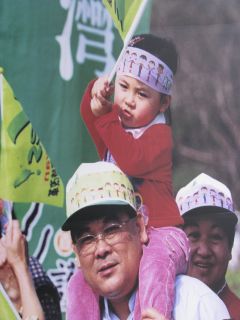The greatest insight and inspiration from the Sunfl ower Movement is that no political figure, no political party and no foreign power will be able to dictate the evolution of crossstrait relations. The Taiwanese people upheld democracy, transparency and sovereignty. It is precisely this attitude that will act as the major force in deciding Taiwan’s future.
Liu Shih-chung, president of Taiwan Brain Trust
Published with permission
During the past six years, the government of President Ma Ying-jeou pushed forward cross-strait ties at a fast pace until it found itself in a tight spot in March this year. The Sunflower Movement, launched by Taiwanese civil society and students, added a new, different voice to Taiwan’s public discourse on crossstrait relations which has long been dominated by the blue (Kuomintang) and green (Democratic Progressive Party) political camps. It also created new complexities for Taiwan’s relationship with China. The Sunflower Movement unfolded when students occupied the Legislative Yuan, Taiwan’s parliament. The events during the following three weeks exposed President Ma Ying-jeou’s leadership crisis, triggered international debate and attention and fomented support from the majority of the Taiwanese public. It was an expression of the insecurities and misgivings prevailing at the grassroots level of Taiwanese society about the speed and breadth, with which the Ma administration fast-tracked cross-strait relations. The fuse that set off this movement was the Ma government when it tried to ram the Cross-Strait Service and Trade Agreement on trade in services through the legislature, in violation of the negotiation mechanism between the ruling and the opposition parties and due process.
As the Sunfl ower Movement kept brewing for more than two months, Taiwan, the United States and China all three considered and examined the events from different angles. They also adjusted their respective strategies in different ways to respond to the protests.
In Taiwan, the ruling KMT and the Ma government continued to isolate some of the movement’s leaders and used international propaganda to discredit the movement’s legitimacy in a bid to play down its impact, albeit to little avail. After Tsai Ing-wen took over as the new chairperson of the major opposition DPP, the DPP adopted a two-pronged strategy of absorbing talent and integrating policy to create the impression that the DPP accepts the outcome of the Sunflower Movement. However, we should observe whether differences emerge over the advocacy of certain policies when the DPP and the civic groups subsequently fine-tune their positions.
The United States responded with an objective conclusion regarding the trade protests in the June report by the US-China Economic and Security Review Commission. It said that Ma committed a severe blunder in facing the opposing voices of civil society and that cross-strait dialogue on political issues is unlikely to take place during the remainder of his term. Daniel Russel, assistant secretary of state for East Asian and Pacifi c affairs, also noted that “the United States does not take a view on any particular agreement and we believe strongly that the pace and scope of movement in cross-strait discussion must be one that is in accord with the comfort level and the wishes of the people on both sides of the strait.” Some US experts have expressed Washington hope that China should strengthen dialogue with the DPP and the Taiwanese people in the future.
China earnestly faced the complex implications that the Sunflower Movement created for crossstrait relations. The researchers in the Taiwan Affairs Office of the Chinese State Council first used so-called track 1 1/2 dialogue [involving officials, scholars and research institutions] to engage in discussions with the United States. At the same time, they visited Taipei to meet with researchers of Taiwan Brain Trust, a pro-green think tank. Originally, observers speculated that the Taiwan itinerary of Taiwan Affairs Office Director Zhang Zhijun could be affected by the postponement of the Service and Trade Agreement. Nevertheless, Zhang decided to visit Taiwan in late June to intensify contacts with central and southern Taiwan, small and mid-sized enterprises, the middle and lower classes as well as young people. Despite being tailed by crowds of protesters, Zhang still met with Kaohsiung City Mayor Chen Chu of the DPP. In contrast to the visit of Chen Yunlin, chairman of China’s Association for Relations Across the Taiwan Strait (ARATS), five years ago, when the DPP mobilized its supporters for protests, the DPP this time exerted restraint. While the party was criticized for that in Taiwan as being too soft [on China], Washington signaled its approval.
In the wake of the tumultuous Sunflower Movement, it has certainly become impossible for a number of bills including the Service and Trade Agreement, the Cross-strait Negotiations Monitoring Act and the Free Economic Pilot Zones scheme to be adopted this summer. Beijing and Washington are equally aware of this. They have also begun to map out strategies for the time after a possible victory of the DPP in year-end local elections. Should the outcome of the local elections improve the DPP’s chances to make a comeback as the ruling party in 2016, Beijing will most likely step up pressure on Taipei. Aside from using Washington to exert pressure on the DPP’s likely presidential candidates, Beijing will also ponder how it can ensure that the KMT manages to defend its grip on power. Beijing will of course continue to engage in dialogue with the DPP in a bid to cause internal rifts in the DPP over China policy and to ensure that, should the DPP return to power in 2016, Beijing still controls the crossstrait agenda.
Anyhow, the greatest insight and inspiration from the Sunfl ower Movement is that no political figure, no political party and no foreign power will be able to dictate the evolution of crossstrait relations. The Taiwanese people upheld democracy, transparency and sovereignty. It is precisely this attitude that will act as the major force in deciding Taiwan’s future.



